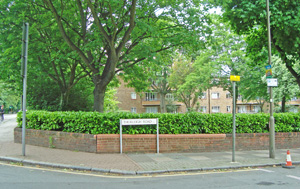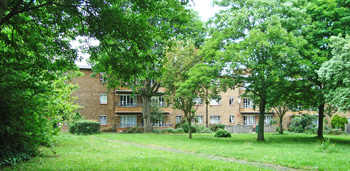Battersea Borough
Maternity Home
Maternity Home
19-20 Bolingbroke Grove, Battersea, SW11 6EW
Medical
dates:
Medical
character:
Maternity
In 1920 the Battersea Borough
Council bought two large houses on the east side of Bolingbroke Grove,
overlooking Wandsworth Common. It was intended that these
buildings, built as private dwellings but used during the 1910a as
retreats for alcoholics, would be transformed into a maternity home,
which the Borough lacked.
The houses - Westwood Tower at No. 19 and Elmhurst at No. 20 - were purchased, adapted and equipped at a cost of £18,851. The two buildings were united by a communicating corridor at the semi-basement level.
The Battersea Borough Maternity Home opened on 21st February 1921 (the official opening ceremony took place on 5th March). It was one of the first municipal maternity hospitals to open.
As well as 30 beds for in-patients (excluding cots, labour beds and isolation beds), the Maternity Home had an Out-Patients Department with a well-equipped Ante-Natal Centre.
In No. 19 (Westwood Tower) the ground floor contained a Waiting Room, two wards, a Receiving Room (where the patient was bathed and prepared before being taken to the Labour Ward), a Labour Ward, and a Night and Day Nursery. There were also a pantry, two storerooms and a WC with wash basin.
On the first floor were 3 more wards, a Labour Ward, an Isolation Ward, a Duty Room, as well as a washroom and WC, a bathroom and a Sluice Room. On the second floor were six rooms, a bathroom and WC, and a tank room. There was also a room at roof level in the tower.
Five beds and a Labour Ward were set aside for women with venereal disease.
The semi-basement of No. 19 was used as an Out-Patients Department, with a Waiting Room, a Nurses' Room, Doctors' Room and Matron's Room. It also contained the Maids' Dining Room, a Linen Room, a Dirty Linen Room and a storeroom, as well as the stoker's room, a coal store, a heating chamber (furnace) and two WCs (one with a washbasin). (Another WC with washing facilities was added later.) The semi-basement of No. 20 contained the kitchen, scullery and larder, together with the Nurses' Dining Room, a Lecture Room, a WC and a heating chamber.
The ground floor of No. 20 (Elmhurst) contained two wards, a bathroom, and the Doctor's Sitting Room. There were six rooms on the first floor - the Nurses' Sitting Room, the Doctor's bedroom, Matron's bedroom and sitting room, and two further bedrooms. Between the ground and first floor was a bathroom and WC. Five staff bedrooms and a bathroom and a WC with washbasin were located on the second floor.
A rota of local medical practitioners, who were available for attendance, could be called upon by Matron, if necessary.
At the end of 1921 a District Midwifery Service was established. The District midwife and her pupil were located in the Town Hall in Lavender Hill - a central situation so that she could more rapidly be accessible to those needing her services. The Midwife's rooms were connect by telephone to the Maternity Home, and patients needing her services at night could phone from a police station.
In 1922 the Maternity Home became a recognised training institution for pupil-midwives.
In 1929 an extension was built at a cost of £4,182.
At the end of 1935, when the Maternity Home had been open for 14 years, some 7,587 babies had been born there.
In 1936 the nursing staff consisted of a Matron, a Sister and 4 Staff Nurses, and a Borough Midwife who provided the District Service. The average number of beds occupied during the year was 17 (60%). However, shortage of staff resulted in the Maternity Home having to close temporarily for ten weeks.
Because of the small staff and consequent lack of social amenities, the Maternity Home was unable to compete with the larger London hospitals to attract staff, in a period when there was a general shortage of nurses. By 1938 the Maternity Home had become seriously understaffed, with 3 vacancies for Staff Nurses. As nurses resigned, it had proved impossible to replace them, despite repeated advertisements, and it was necessary to employ nurses from private associations. The new regulations of the Central Midwives' Board added to the difficulties, since the number of pupil-midwives had to be reduced from 8 to 6.
The Borough Council considered the situation. The buildings were over 60-70 years old and needed considerable repair. Cracks had been appearing in both buildings for some years, with movement of the foundations at the southeast corner of Elmhurst. The south and east walls had begun to bulge. A large crack in the wall of Ward 4 on the ground floor of Westward Tower had appeared suddenly at night, and had been heard by the patients on the ward.
Reluctant to pay for the expense of underpinning of the houses and, in view of the availability of other maternity accommodation in London, the Council felt it had no alternative but to close the Maternity Home and terminate the District Midwifery Service.
No patients were admitted after 31st January 1939, and the last one was discharged on 9th February.
During its 18-year existence, some 8,842 mothers had been confined within (about 21% of Battersea births), with only 10 maternal deaths.
The houses - Westwood Tower at No. 19 and Elmhurst at No. 20 - were purchased, adapted and equipped at a cost of £18,851. The two buildings were united by a communicating corridor at the semi-basement level.
The Battersea Borough Maternity Home opened on 21st February 1921 (the official opening ceremony took place on 5th March). It was one of the first municipal maternity hospitals to open.
As well as 30 beds for in-patients (excluding cots, labour beds and isolation beds), the Maternity Home had an Out-Patients Department with a well-equipped Ante-Natal Centre.
In No. 19 (Westwood Tower) the ground floor contained a Waiting Room, two wards, a Receiving Room (where the patient was bathed and prepared before being taken to the Labour Ward), a Labour Ward, and a Night and Day Nursery. There were also a pantry, two storerooms and a WC with wash basin.
On the first floor were 3 more wards, a Labour Ward, an Isolation Ward, a Duty Room, as well as a washroom and WC, a bathroom and a Sluice Room. On the second floor were six rooms, a bathroom and WC, and a tank room. There was also a room at roof level in the tower.
Five beds and a Labour Ward were set aside for women with venereal disease.
The semi-basement of No. 19 was used as an Out-Patients Department, with a Waiting Room, a Nurses' Room, Doctors' Room and Matron's Room. It also contained the Maids' Dining Room, a Linen Room, a Dirty Linen Room and a storeroom, as well as the stoker's room, a coal store, a heating chamber (furnace) and two WCs (one with a washbasin). (Another WC with washing facilities was added later.) The semi-basement of No. 20 contained the kitchen, scullery and larder, together with the Nurses' Dining Room, a Lecture Room, a WC and a heating chamber.
The ground floor of No. 20 (Elmhurst) contained two wards, a bathroom, and the Doctor's Sitting Room. There were six rooms on the first floor - the Nurses' Sitting Room, the Doctor's bedroom, Matron's bedroom and sitting room, and two further bedrooms. Between the ground and first floor was a bathroom and WC. Five staff bedrooms and a bathroom and a WC with washbasin were located on the second floor.
A rota of local medical practitioners, who were available for attendance, could be called upon by Matron, if necessary.
At the end of 1921 a District Midwifery Service was established. The District midwife and her pupil were located in the Town Hall in Lavender Hill - a central situation so that she could more rapidly be accessible to those needing her services. The Midwife's rooms were connect by telephone to the Maternity Home, and patients needing her services at night could phone from a police station.
In 1922 the Maternity Home became a recognised training institution for pupil-midwives.
In 1929 an extension was built at a cost of £4,182.
At the end of 1935, when the Maternity Home had been open for 14 years, some 7,587 babies had been born there.
In 1936 the nursing staff consisted of a Matron, a Sister and 4 Staff Nurses, and a Borough Midwife who provided the District Service. The average number of beds occupied during the year was 17 (60%). However, shortage of staff resulted in the Maternity Home having to close temporarily for ten weeks.
Because of the small staff and consequent lack of social amenities, the Maternity Home was unable to compete with the larger London hospitals to attract staff, in a period when there was a general shortage of nurses. By 1938 the Maternity Home had become seriously understaffed, with 3 vacancies for Staff Nurses. As nurses resigned, it had proved impossible to replace them, despite repeated advertisements, and it was necessary to employ nurses from private associations. The new regulations of the Central Midwives' Board added to the difficulties, since the number of pupil-midwives had to be reduced from 8 to 6.
The Borough Council considered the situation. The buildings were over 60-70 years old and needed considerable repair. Cracks had been appearing in both buildings for some years, with movement of the foundations at the southeast corner of Elmhurst. The south and east walls had begun to bulge. A large crack in the wall of Ward 4 on the ground floor of Westward Tower had appeared suddenly at night, and had been heard by the patients on the ward.
Reluctant to pay for the expense of underpinning of the houses and, in view of the availability of other maternity accommodation in London, the Council felt it had no alternative but to close the Maternity Home and terminate the District Midwifery Service.
No patients were admitted after 31st January 1939, and the last one was discharged on 9th February.
During its 18-year existence, some 8,842 mothers had been confined within (about 21% of Battersea births), with only 10 maternal deaths.
Present status (June 2012)
The buildings suffered bomb blast damage during WW2 (1939-1945) and were demolished around 1948. The grounds of an apartment block - Lane Court - now occupy the site.

The Maternity Home would have been between Thurleigh Road and Blenkarne Road along Bolingbroke Grove. Its site is now part of the grounds of Lane Court (above and below).

Campbell JM 1921 Maternity homes. Lancet 198 (5107), 162-164.
Macdonald G 1935 Report on the Health of the Metropolitan Borough of Battersea. London, Battersea Borough Council, 4.
Macdonald G 1938 Report on the Health of the Metropolitan Borough of Battersea. London, Battersea Borough Council, 3, 128-133.
Quin Lennane G 1920 Report on the Health of the Metropolitan Borough of Battersea. London, Battersea Borough Council, 21.
Quin Lennane G 1922 Report on the Health of the Metropolitan Borough of Battersea. London, Battersea Borough Council, 26-30.
www.ucl.ac.uk (1)
www.ucl.ac.uk (2)
Return to home page